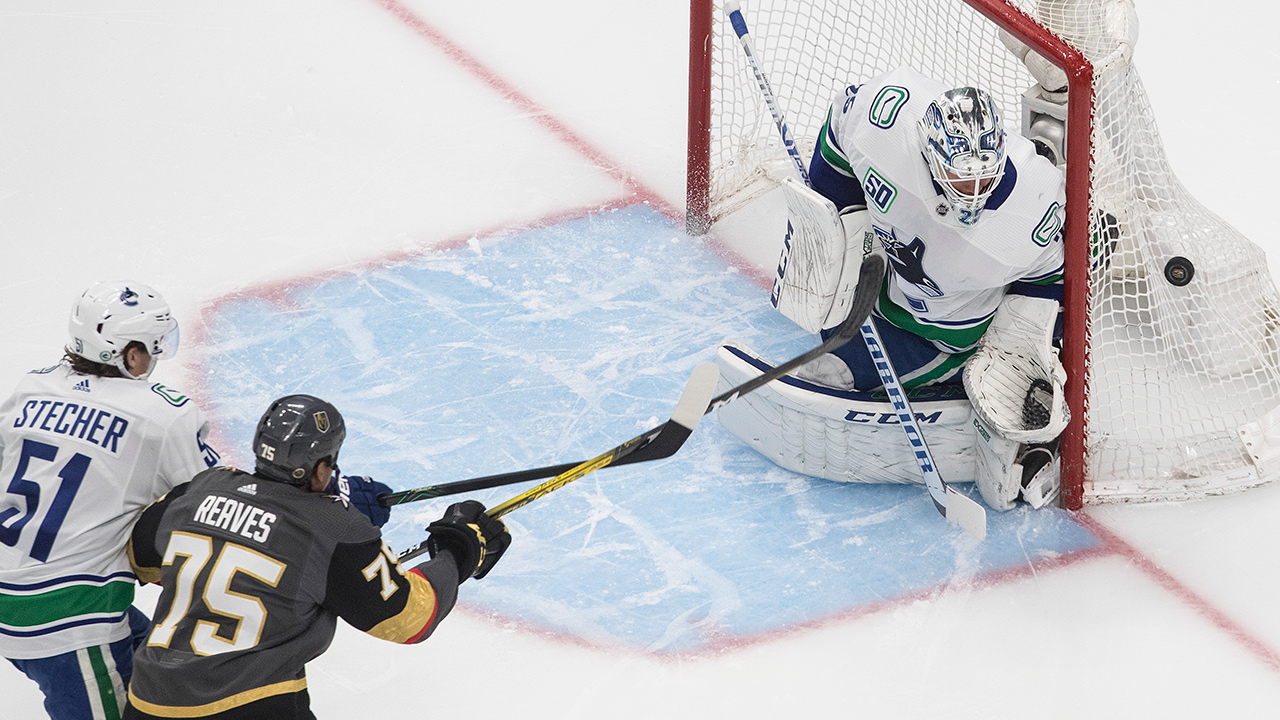In what has become a predictable outcome when things look dire for the Vancouver Canucks, the team rallied for a gigantic win over their heavily favoured opponents on Tuesday, coming out of the gates on fire and opening the scoring just under 90 seconds into the game.
In breaking down what the Canucks needed to do to beat the Golden Knights, I pointed to their lack of rush scoring ability as a hindrance to climb back in games against teams that can overwhelm on the cycle and forecheck like Vegas can, so it was paramount to get ahead first and try to build on that.
That’s exactly what the Canucks pushed for and accomplished in Game 2, helped by what has become a regular occurrence in these playoffs: a great performance by Jacob Markstrom.
Markstrom has been right up there with Quinn Hughes and Elias Pettersson as key reasons for this Canucks team making an unlikely run, but how big of a factor has he been overall? To find out, let’s look at his performance in a few different ways, breaking things down on a game-by-game basis.
No goaltender stops everything all the time, and Markstrom is no exception. He has had a few rough games in these playoffs, but has been essentially at or above expected performance level in nine of the 12 games he’s played so far.
Each game where he’s given up more goals than expected, he’s responded with a big performance for his team, and hasn’t had a really rough outing since the final game of the qualifying round where the Canucks eliminated the Minnesota Wild in overtime.
Overall, in all situations, Markstrom is saving about 0.335 goals above expectations compared to the rest of the goalies in the playoffs in an average game, which gives the Canucks a solid starting point to build on each time they take the ice.
Goals saved above expectations gives us a general idea of the impact Markstrom has had on the game, but where has that impact been most felt? What gives the Canucks the confidence to take chances offensively, knowing he has their backs? Let’s look at how Markstrom compares to the rest of the goaltending in the playoffs when we break the shots he’s faced down by area of the ice.
[relatedlinks]
Specifically, we’ll look at the inner slot, where goaltenders have saved 78.7 per cent of the shots; the high slot, where they’ve saved 89.1 per cent of the shots; and the perimeter, where they’ve saved 97 per cent of the shots.
Knowing the average save percentage from each zone, it should be obvious that the biggest impact a goaltender can have is on the inner slot, where about half of all goals are scored in the NHL and 51.2 per cent during these playoffs. There isn’t a big gap between being average on perimeter shots and being perfect, so unless a goalie is really struggling there, it’s usually not an area to focus on.
One of the biggest reasons why I expected the Canucks to lose to the Wild was that Minnesota is incredible at controlling the inner slot area of the ice, giving up almost nothing and getting a good share of shots from there themselves. Over the first three games of that qualifying round, Markstrom set the tone of the series by stopping every single shot from the inner slot, over 20 per cent better than league average, to help the Canucks open up a 2-1 series lead.
Markstrom struggled a lot from the high slot early on in the playoffs, but has managed to be around average or better for the rest of the playoffs so far, shutting teams out from the high slot in six of the 10 following games.
After the dam finally broke from the inner slot against the Wild, Markstrom had a rough stretch in front of his crease for a few games, one against the Wild and then three straight games against St. Louis, with the much bigger and more physical Blues (compared to the Wild) getting in his kitchen and causing more havoc in front of the net.
After a few games though, Markstrom once again found his composure on those shots in tight, and was only beaten once from the inner slot against the Blues in the final two games of the series, both wins for the Canucks.
[snippet id=4931161]
Against Vegas, Markstrom was perfect outside the inner slot, but was beaten five times on 10 shots from the inner slot, which sounds horrendous but the Canucks were truly blown up in that game by the Golden Knights’ relentless attack. Markstrom did allow five goals, but the Golden Knights built up over four expected goals worth of scoring chances. It was a rough outing for Markstrom, but he wasn’t beat by any poor shot and stopped a ton of great chances in the game. I believe that in games like that, there is a bit of a cascading effect on goaltenders that isn’t yet captured by shot quality metrics.
Like the rest of his team, Markstrom responded brilliantly in Game 2, stopping every Golden Knights shot from the inner slot, though he was a little below average in the other areas of the ice.
Obviously, Markstrom is not immune to a bad outing – no goaltender is – but his consistency so far in these playoffs has been pretty strong, and his ability to bounce back after an underwhelming game gives the Canucks that swagger you need to have success in the post-season.











